The following is a summary of global temperature conditions in Berkeley Earth’s analysis of November 2022.
- Globally, November 2022 was the 11th warmest November since records began in 1850.
- On land, November 2022 was unusually cold, with only the 18th warmest November since 1850.
- Warm conditions occurred in the Middle East, eastern Asia, southern South America, and parts of the Pacific Ocean.
- Unusually cool conditions were present in Australia, Antarctica, the Western United States, and the eastern Equatorial Pacific.
- Mild-to-Moderate La Niña conditions are present, and La Niña is expected to continue until next year.
- 2022 is likely to be the 5th warmest year.
Global Summary
Globally, November 2022 has been the eleventh warmest November since records began in 1850. This November was the coldest of the last 8 years, and significantly colder than recent warm years including 2020, 2019 and 2015. Despite being colder than most recent years, November 2022 was nonetheless warmer than any November prior to 2007.
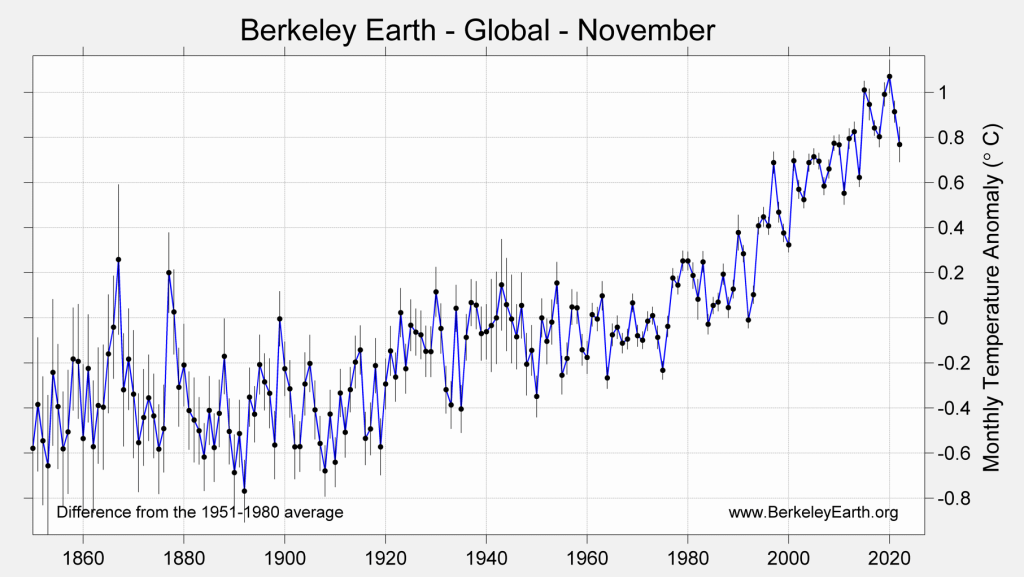
The global mean temperature in November 2022 was 0.77 ± 0.08 °C (1.38 ± 0.14 °F) above the 1951 to 1980 average, which is a sharp decrease from October.
This is equivalent to being 1.10 ± 0.09 °C (1.97 ± 0.17 °F) above the 1850 to 1900 average, which is frequently used as a benchmark for the preindustrial period.
The global mean temperature anomaly in November 2022 was a sharp decrease of 0.24 °C (0.43 °F) colder than October 2022, and appreciably colder than any other month thus far in 2022. The relatively sharp decrease in November temperatures was driven mainly by unusually cold temperatures in land areas, particularly Australia, Antarctica, and western North America. Temperatures in November were close to, but below the long-term trend line, and it was the coldest month since February 2021.

Spatial Variation
November 2022 continues the ongoing pattern of widespread warmth, though with some notable exceptions. Particularly warm conditions were present in the Middle East, eastern Asia, and southern parts of South America. Record setting warmth was also present in significant portions of the North and South Pacific, and parts of the Atlantic. Particularly cool conditions were present in Australia, the eastern United States, Antarctica, and the Eastern equatorial Pacific Ocean.
We estimate that 5.4% of the Earth’s surface experienced their locally warmest November average, and 70% of the Earth’s surface was significantly warm when compared to their local average during the period 1951 to 1980. In addition, 0.6% of the Earth’s surface had their locally coldest November.
The large cool area in the eastern Equatorial Pacific is consistent with the ongoing La Niña conditions.
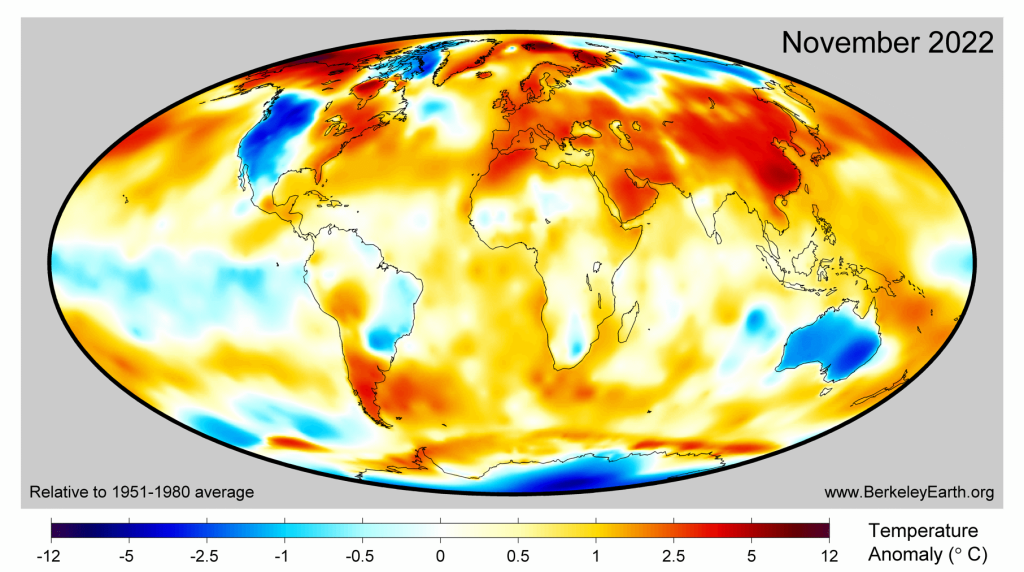

Over land regions, 2022 was the 18th warmest November ever observed. The land average was 0.88 ± 0.16 °C (1.58 ± 0.28 °F) above the 1951 to 1980 average. This is a sharp decrease of 0.65 °C (1.2 °F) from October, which was the warmest October on land. This cooling was particularly prominent in Australia and Antarctica, with Antarctica including a large area with the monthly average temperature at record lows for November.
November 2022 was the 5th warmest November in the oceans, recorded as 0.61 ± 0.04 °C (1.10 ± 0.07 °F) above the 1951 to 1980 average. This is largely indistinguishable from other recent years, though markedly cooler than in 2015 and 2019. This moderately low rank is influenced, in part, by the cooling effects of the ongoing La Niña event.

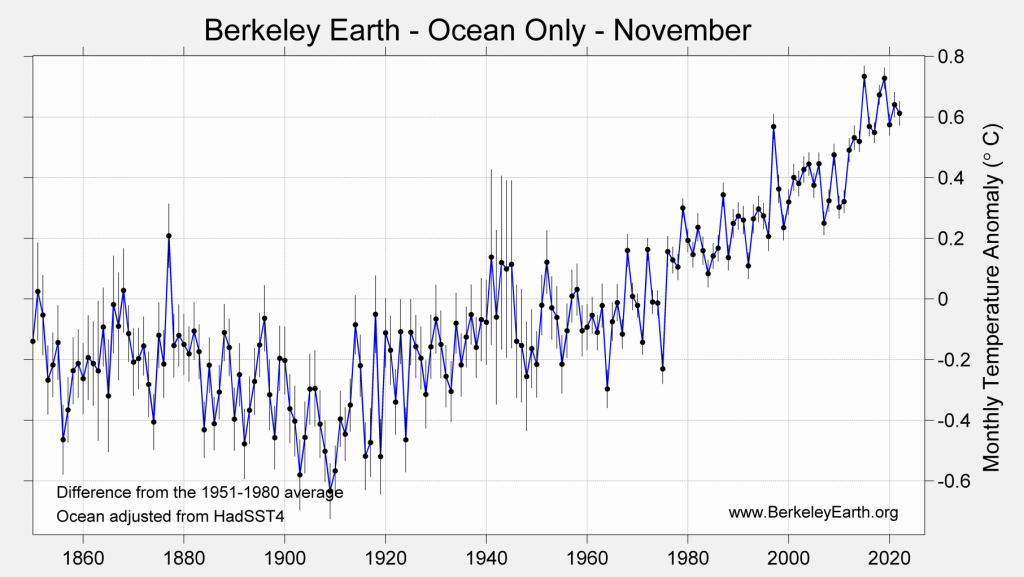
Seasonal Temperatures (September to November)
The September to November period (fall in the Northern Hemisphere and spring in the Southern Hemisphere) was the 6th warmest such period on record. It was noticeably cooler than the previous three years, though well above all averages prior to the year 2010.

The previous three months are characterized by widespread warmth with the notable exceptions of Australia, Antarctica, and the Eastern Equatorial Pacific.


Australia was particularly notably for having completed the coldest spring since 2004.
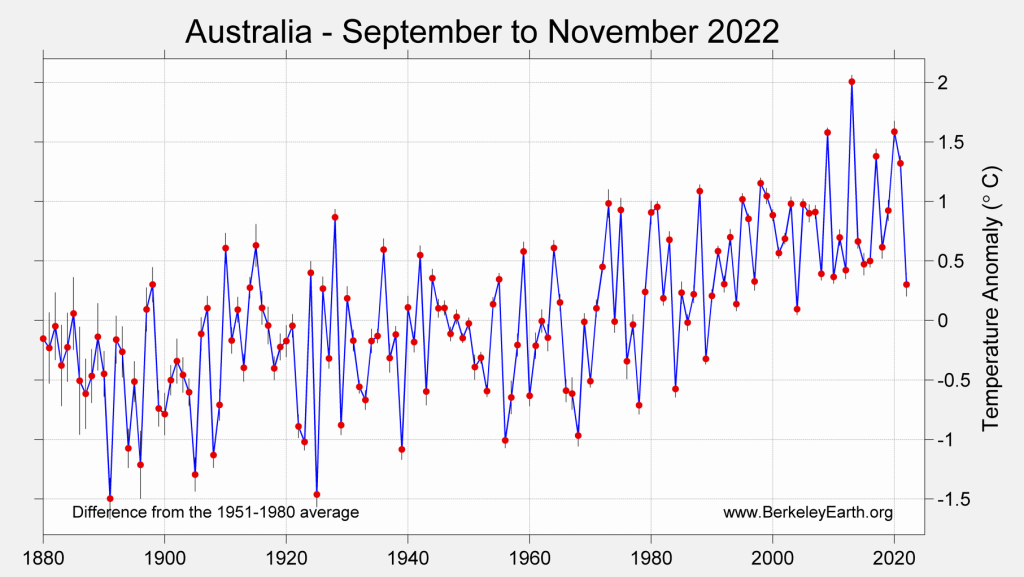
La Niña
November 2022 had well-defined mild-to-moderate La Niña conditions in the Pacific Ocean. The La Niña phenomenon, associated with relatively cool water in the Eastern equatorial Pacific, is a form of seasonal weather variability that is generally associated with cooler global average temperatures. The current La Niña event began in 2020 and has exhibited surprising longevity. This La Niña is likely to continue into the next year. The CPC/IRI analysis suggests that La Niña conditions are likely into the start of next year, with only a <10% chance of a shift to El Niño conditions before the middle of 2023.
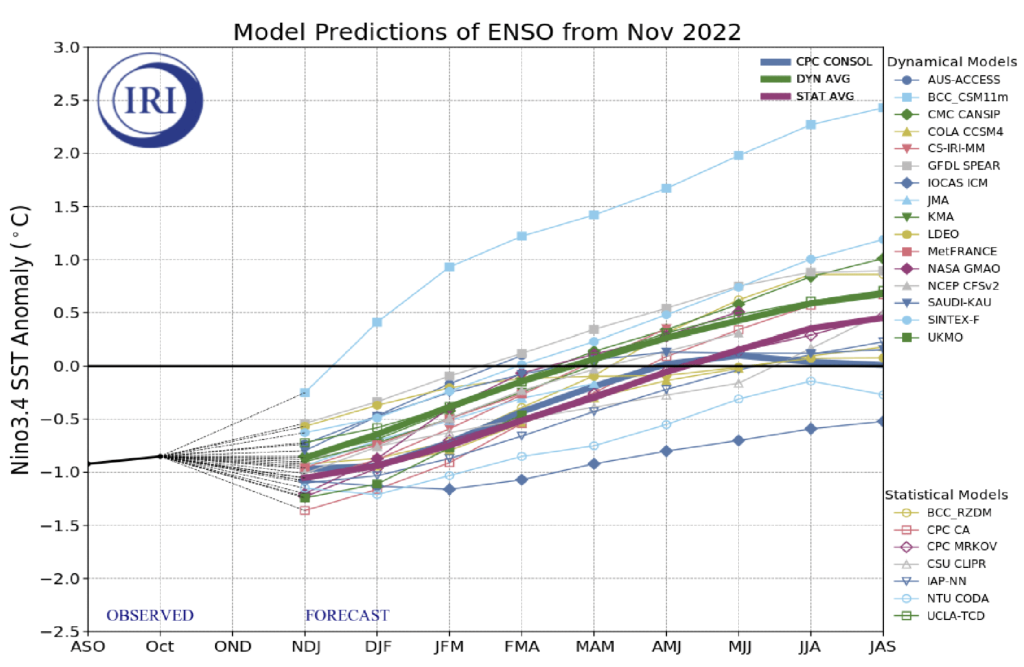
Year to Date
November was the coolest month of 2022. June, July, August, and October were each only slightly below their corresponding monthly records, while January through May, and September were more noticeably below their corresponding records. Nonetheless, every month in 2022 has been at least 1.1 °C (2.0 °F) warmer than the 1850-1900 average. As a result, 2022 is currently positioned as the 5th warmest year.
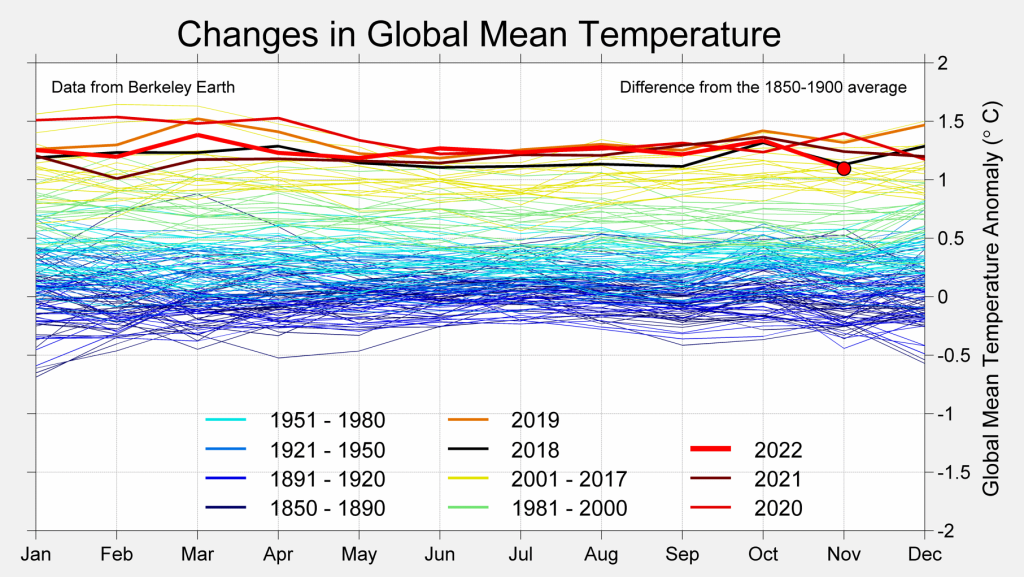
The most prominent spatial features of year-to-date temperatures are the cool La Niña pattern in the Pacific, warmth over Asia and Europe, and record warmth in the North and South Pacific. Year-to-date, 8.6% of the Earth’s surface has experienced record warmth. No part of the Earth’s surface has been record cold in its year-to-date average.
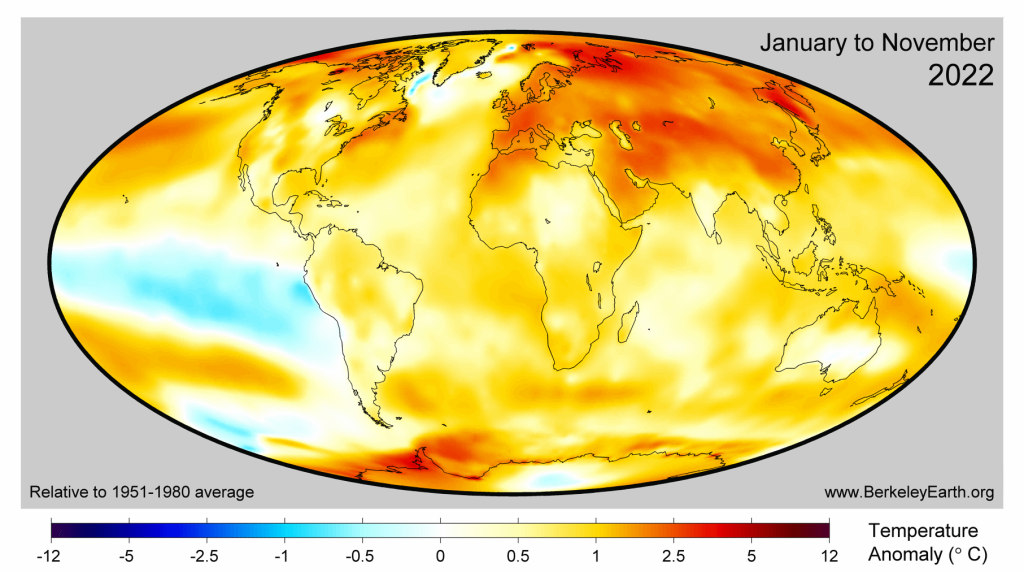
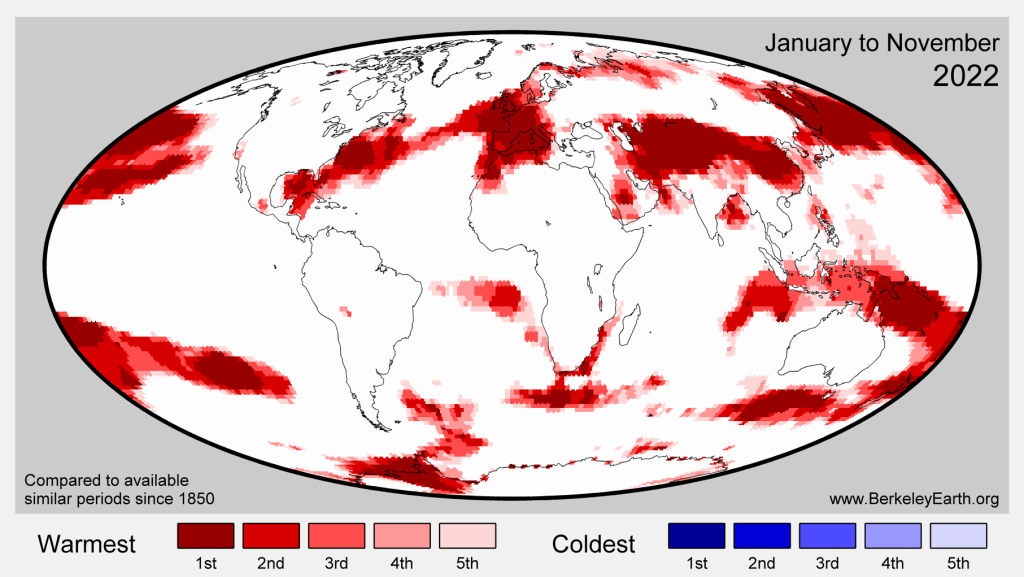
Rest of 2022
Year-to-date temperatures make it certain that 2022 will be cooler than recent record warm years; however, 2022 is likely to be 5th warmest year overall.
The statistical approach that we use, looking at conditions in recent months, believes that 2022 is likely to be the 5th warmest year in the instrumental record (90% likelihood), with modest chances of either a 4th or 6th place finish. It is very unlikely (<1%) that the remainder of 2022 warms enough for 2022 to be within the top 3 warmest years. It is also very unlikely that 2022 will be any cooler than the 6th warmest, which means that this year is very likely to still surpass all years prior to 2015.
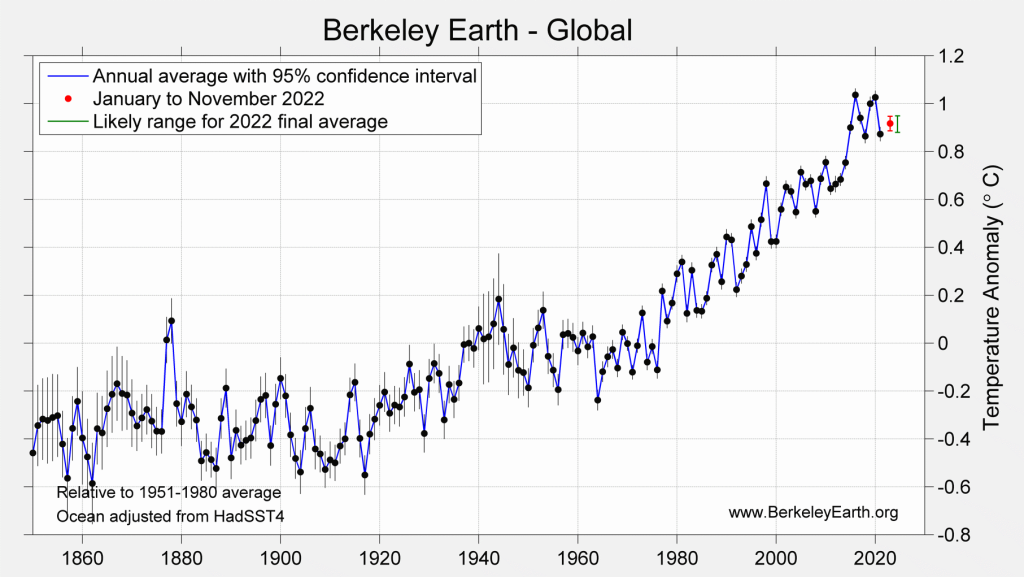
Likelihood of final 2022 ranking:
- 1st place (< 1 %)
- Top 3 overall (< 1 %)
- 4th place (1 %)
- 5th place (90 %)
- 6th place (9 %)
- Top 6 overall (> 99 %)

